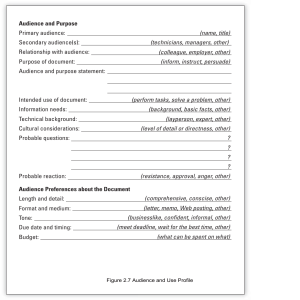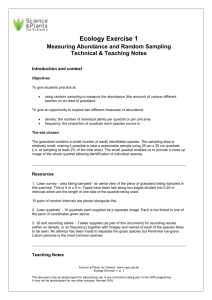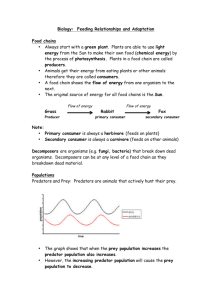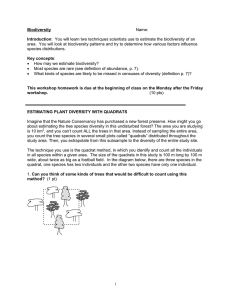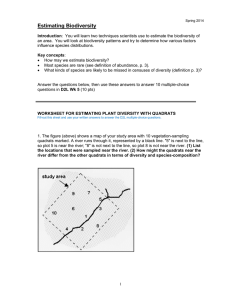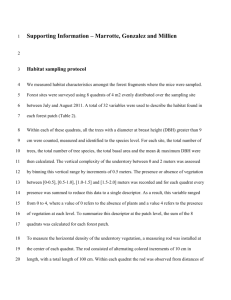This file was created by scanning the printed publication.
advertisement
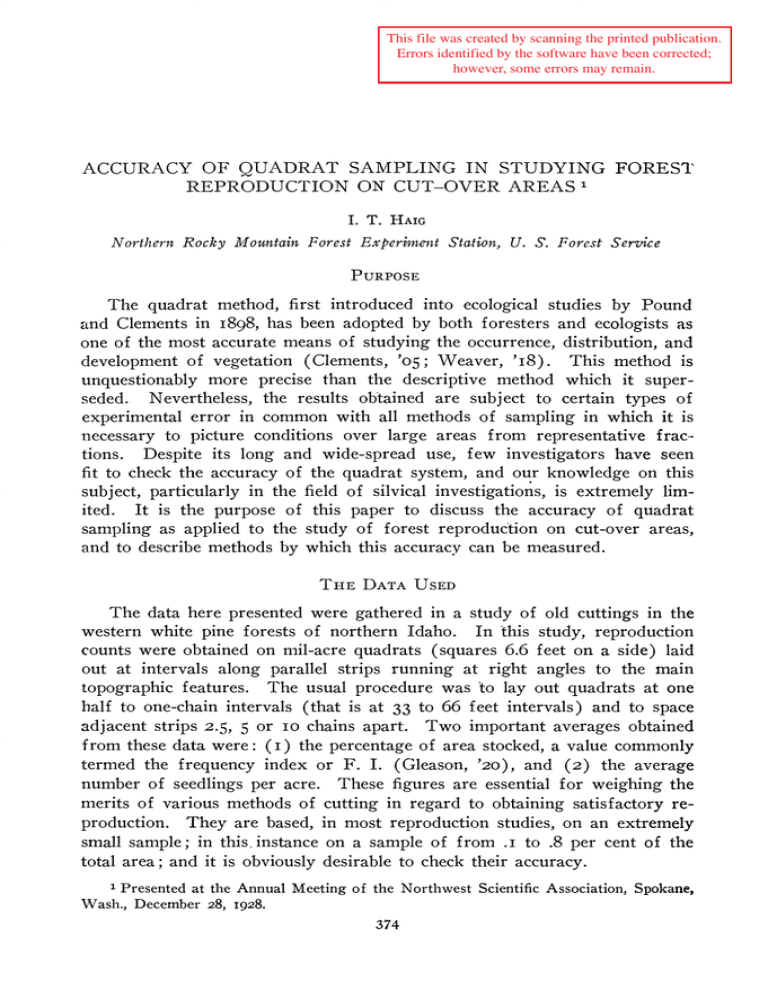
This file was created by scanning the printed publication.
Errors identified by the software have been corrected;
however, some errors may remain.
ACCURACY OF QUADRAT SAMPLING IN STUDYING
REPRODUCTION ON CUT-OVER AREAS1
FOREST
I. T. HAIG
Northern Rocky Mountain Forest Experiment Station, U. S. Forest Service
PURPOSE
The quadrat method, first introduced into ecological studies by Pound
and Clements in i898, has been adopted by both foresters and ecologists as
one of the most accurate means of studying the occurrence, distribution, and
This method is
development of vegetation (Clements, '05; Weaver, 'i8).
unquestionably more precise than the descriptive method which it superseded. Nevertheless, the results obtained are subject to certain types of
experimental error in common with all methods of sampling in which it is
necessary to picture conditions over large areas from representative fractions. Despite its long and wide-spread use, few investigators have seen
fit to check the accuracy of the quadrat system, and our knowledge on this
subject, particularly in the field of silvical investigations, is extremely limited. It is the purpose of this paper to discuss the accuracy of quadrat
sampling as applied to the study of forest reproduction on cut-over areas,
and to describe methods by which this accuracy can be measured.
THE DATA USED
The data here presented were gathered in a study of old cuttings in the
western white pine forests of northern Idaho. In this study, reproduction
counts were obtained on mil-acre quadrats (squares 6.6 feet on a side) laid
out at intervals along parallel strips running at right angles to the main
topographic features. The usual procedure was 'to lay out quadrats at one
half to one-chain intervals (that is at 33 to 66 feet intervals) and to space
adjacent strips 2.5, 5 or i0 chains apart. Two important averages obtained
from these data were: (i) the percentage of area stocked, a value commonly
termed the frequency index or F. I. (Gleason, '20), and (2) the average
number of seedlings per acre. These figures are essential for weighing the
merits of various methods of cutting in regard to obtaining satisfactory reproduction. They are based, in most reproduction studies, on an extremely
small sample; in this, instance on a sample of from .i to .8 per cent of the
total area; and it is obviously desirable to check their accuracy.
1 Presented at the Annual Meeting of the Northwest Scientific Association, Spokane,
Wash., December 28, i928.
374
October,
ACCURACY
I929
FREQUENCY
OF QUADRAT
INDEX
375
SAMPLING
IN OCCURRENCE
OF SEEDLINGS
Accordingly, frequency index (percentage of area stocked) was checked
in the following manner. In addition to tallying reproduction on quadrats
at half-chain or one-chain intervals along parallel strips, the usual method
of study designated in this paper as the quadrat-at-interval method, a tally
was made on strips of contiguous quadrats distributed over the same area
in a similar manner. This tally simply noted the presence or absence of
reproduction by individual quadrats, and furnished data from which to
compute F. I.'s based on from five to twenty times the usual sample as obtained by the quadrat-at-interval method. These frequency indices, therefore, act as a standard against which to check the accuracy of the F. I.'s
obtained by the quadrat-at-interval method, and a comparison of this sort
for six cut-over areas is shown in Table I.
TABLE I.
Check of frequency indices
Cut-over
Method
of
I
F. I. Basis
Sampling
_%
Quadrats contiguOus......
90
2
F. I. Basis
Area Number
3
F. I. Basis
4
F. I. Basis
5
F. I. Basis
Quads
%
Quads
%
Quads
%
Quads
/%
Quads
468
92
782
84
9I3
92
479
69
759
7I
100
45
96
98
I09
77
I23
6
F. I. Basis
%
86
Quads
507
Quadrats at intervals .
88.....
96
100
29
The reasonably close agreement of these figures indicates that the quadrat-at-interval method gives sufficiently accurate results in spite of the
meagerness of the sample. The significant differences, however, show the
need for caution in deciding the relative merits of two cut-over areas on the
basis of differences in frequency index. Such differences might be attributed,
in part or in whole, to accidents of sampling as well as to dissimilarity in
conditions on the cut-over areas or in methods of cutting.
AVERAGE
NUMBER
OF SEEDLINGS
PER ACRE
Checking the values for average number of seedlings per acre proved a
much more difficult task. Statisticians (Student, 'o8) offer a very definite
method of checking the accuracy of averages through the use of the probable error concept. But it is generally assumed that this statistical measure
is directly applicable only to normal or nearly normal frequency distributions, illustrated in figure I, A, in which the individual values obtained in
sampling are distributed around the average value in an orderly progressive
fashion, though it is also held probable that the deviation from normality
I. T. HAIG
376
Ecology, Vol. X, No.4
NORMAL FREQUENCY DISTRIBUTION
20
6
_
10
60
80
5
7
40D
NUMBER OF SEEDLINGS PER QUADRAT
203O
90
100
90
100
90
100
ORIGINAL DISTRIBUTION - DALKENA AREA
0
10
20
80
30
40
50
60
70
NUMBEROF SEEDLINGS PER QUADRAT
REVISED
DISTRIBUTION-
C)ALKENA AREA
12__
0
10
20
30
40
50
60
70
80
NUMBER OF SEEDLINGS PER QUADRAT
FIG.
I. Types of frequency distributions.
October,
I929
ACCURACY
OF QUADRAT
SAMPLING
377
must be extreme to lead to serious error. In this study the frequency distributions are of an extreme type, being very much skewed in a plus direction. This type of distribution, based on the data for one of the cut-over
areas studied, is shown in figure I, B. Ordinary statistical methods for
measuring the accuracy of averages cannot be applied accurately to this
type of distribution, and it was necessary to convert these distributions to
normal or more nearly normal distributions before such checks could be
made.
METHOD
OF TESTING
DISTRIBUTIONS
A review of available statistical literature failed to suggest any method
of testing the accuracy of averages obtained from such J-shaped distributions, or of converting such distributions to more normal proportions.
Quartile deviation is the measure of dispersion often recommended for use
with skewed distributions (Mills, '24), but this obviously is not applicable
to the arithmetical average, the item of major interest in this particular
study. It was necessary, therefore, to develop methods of treatment applicable to this extremely skewed type of distribution. Close study of the
frequency curve in figure I, B suggested certain steps that finally led to
successful treatment. Although it was apparent that the definite skewness
of this curve was the result of a combination of causes, the very definite Jshaped character of the curve was due chiefly to the fact that the average
number of seedlings per quadrat was so small as to place the peak of the
frequency curve very close to the zero point. The solution seemed the use
of a larger quadrat containing on the average a greater number of seedlings.
This would push the peak of the frequency curve in a plus direction and
eliminate in large measure the J-shaped character of the distribution. There
are numerous objections to the use of any quadrat other than the mil-acre
as a field unit of measure, but none whatever to the use of a larger unit in
the office analysis. Consequently, mil-acre quadrats were selected at random, arranged in groups of four or eight quadrats and the total sum of
seedlings for each of these groups used as the number of seedlings per new
unit measure. This grouping had the same effect as if the field quadrats
had been four or eight times as large and only one-fourth or one-eighth as
many had been installed. Note that groups of 4's or 8's were used simply
as a matter of convenience. The number of mil-acres incorporated in each
group might have been any number desired, the sole criterion being that
the number in each unit must be large enough to move the average number
of seedlings per quadrat, and hence the peak of the frequency curve, a reasonable distance away from the zero ordinate.
This method of grouping eliminates the J-shaped character of the distribution, but it also reduces the number of quadrats on which the frequency
curve is based and tends to produce weak and erratic distributions. To
2
This method of grouping was originally suggested to the author by Mr. Donald
Bruce.
I. T.
378
Ecology, Vol. X, No.4
HAIG
overcome this objectional feature, this procedure of grouping was repeated
any desired number of times, the entire set of original mil-acre values being
used in each series, but the individual units in each series being formed by
new combinations of different mil-acre values. In this way a new set of
values was built up, the number of quadrats in this array being steadily increased by additional combinations of the original data until these values
produced a reasonably smooth frequency curve. This type of distribution
is shown in figure I, C.
Notice that this curve is still skewed. It was
found impossible to entirely eliminate this factor, but the distribution is now
near enough normal to permit the application of ordinary statistical checks
with reasonable safety.
The use of the same basic data over and over in building up this new
series of quadrats raised some question as to the accuracy of this process
and its consequent effect on the probable error. Accordingly, a check was
made of the effect of this process. The values in Column 2, Table II, show
very definitely that as the number of combinations increases, that is as the
same basic data is used over and over an increasing number of times to
form values for new quadrats, the probable error appears to decrease with
each additional repetition, changing from ii.i per cent (the best available
figure for probable error based on an average of the probable errors of six
individual groupings by 4's or 8's) to 3.5 per cent on a basis of ten such
combinations.
TABLE II.
Check of probable error comfputations
Probable Error
Per Cent
Number of Combinations
Uncorrected Value
(I)
(2)
I......................
.........
......
5.5.I......................
.
7 .*
IO
10.........
3
II.
....
6.5
Corrected Value
(3)
IIJ0
II.2
II.4
4.3
3.5
I I.4
II.I
? Most reliable figure; average of six probable errors each based on one combination by 4'S or 8's.
This reduction is obviously an inaccuracy introduced by the repeated use
of the basic data in various combinations, for ordinarily the probable error
for this array would remain in the neighborhood of ii.i per cent unless
changes were introduced directly into the basic data. It was reasoned that
the decrease in probable error must be directly related to the square root
of the number of combinations and that this error could be eliminated by
multiplying the probable error of an array by the square root of the number of combinations. This assumption was checked empirically and found
correct. The corrected values for probable error listed in Column 3, Table
II, were derived by multiplying the uncorrected values in Column 2 by the
October,I929
ACCURACY
OF QUADRAT
379
SAMPLING
square root of the corresponding number of combinations. Note that the
corrected values are all close to ii.i per cent, the most reliable value for
this array. It is possible, therefore, through the use of 'this correction
factor, to obtain the benefits of a smoother frequency distribution and a
stronger basis in number of quadrat values without introducing inaccuracies
into the computations for probable error. The accuracy of this method of
treatment has not yet been checked on purely theoretical grounds, but the
empirical check here given seems sufficient evidence that the method is
fundamentally sound.
USE
OF METHOD
ON FIVE
CUT-OVER
AREAS
It is now possible by the use of these methods to convert the J-shaped
frequency distributions, probably typical for similar ecological and silvical
studies, into more nearly normal distributions, to which it is permissible to
apply statistical checks. Accordingly, five cut-over areas were selected, the
erratic measurements rejected in the usual manner (Bruce, '24), except that
the skewness required the treatment of plus and minus deviations in separate groups, and the frequency distributions revised by the methods just
described. The probable errors for average number of seedlings per acre
were computed from these revised distributions. These probable errors,
together with the other pertinent data, are listed in Table III. As the selected group of areas embodies several types of cutting, and both large and
small areas, and as the samples collected on these areas vary in size from
the minimum sample, .I per cent, to the maximum sample, .8 per cent, the
errors to which the averages of these areas are subjected should be fairly
representative.
TABLE III.
Cut-over Area
Designation
Probable error of average number of seedlings per acre
Type of
Cut-over Area
Dalkena .......
Shelterwood
Cathcart. . .......Clearcut
.
with Seed Trees
Ryrie-Wright.
Shelterwood
Beardmore...
Clearcut with Seed Group
McManimim....
Clearcut with Seed Trees
Amount of
Total
Area in
Average Number of Seedlings
Sample
Number
Per cent
o.8
0.4
Per Acre
8,300
5,600
0.2
0.2
I4,800
0. I
13,200
9,500
Probable Error
Per cent
7.7
9.7
8.o
6.9
9.6
These probable errors have a very definite and significant meaning. For
example, on the Dalkena area the average number of seedlings per acre is
estimated as 8,300 plus or minus, a probable error of 7.7 per cent. This
means that this estimated value of 8,300 seedlings per acre, based on the
very small sample of .8 of one per cent of the total area, is probably within
7.7 per cent, and almost certainly within 23.1 per cent (three times the
380
I. T.
HAIG
Ecology, Vol. X, No.4
probable error) of the actual number of seedlings per acre that would be
secured by a one-hundred-per-cent cruise of the cut-over area. This statement is based on the usual statistical definition of probable error, namely,
that if each cut-over area were resampled, the new samples consisting of
the same number of mil-acre quadrats as before, distributed in a similar
manner, the new averages would fall within the range formed by the present
average plus or minus the probable error in approximately 50 per cent of
the cases, and within a range of the present average plus or minus three
times the probable error in practically all or approximately 95 per cent of
the cases.
The practical value of these probable errors is apparent. First, they
offer assurance that the method of sampling employed has given averages
accurate enough to insure a true picture of reproduction conditions, for all
of the probable errors in this group are less than IO per cent. Second, the
probable errors show clearly that in weighing the merits of two cut-over
areas, differences in values of average number of seedlings per acre of less
than ten per cent are probably not significant (these can very easily be due
to accidents of sampling alone) and that even differences of as much as 25
per cent must be classed as significant only with reservation.
LOCATION OF QUADRATS
There are two other matters of interest that might be mentioned in connection with quadrat sampling of cut-over areas. First, that it is essential
to distribute the strips very thoroughly over the area. Errors as high as
6o per cent were incurred by concentrating strips on one portion of the
area as opposed to distributing these strips at wider intervals over the entire
area. This is in agreement with the conclusions reached by Gleason ('20),
who, in studying the location of quadrats in ecological studies, found that
the use of one-fourth of the data in contiguous quadrats, that is a concentration of the sample, resulted in an error of IO.7; while the use of onelourth of the data in non-contiguous quadrats gave a corresponding error
of only 2.7.
The second matter was that within certain common-sense limits, given
the same number of mil-acres per unit of cut-over area, the greatest accuracy
was obtained by distributing the quadrats along closely spaced strips with
larger intervals between quadrats as opposed to widely spaced strips and
smaller intervals between quadrats. This statement is based on a study of
the effect of distribution of strips on four cut-over areas. The average
error introduced by using only half the data with twice the usual interval
between quadrats was I7 per cent, as compared to an error of 32 per cent
incurred by using the same amount of data with twice the usual distance
between strips.
October,i929
ACCURACY
OF QUADRAT
SAMPLING
38i
SUMMARY
The purpose of this paper has been to discuss the accuracy of quadrat
sampling as applied to reproduction studies in the western white pine type.
and 'to discuss methods by which this accuracy can be measured. In general, the methods used in this study consisted in counting reproduction on
mil-acre (6.6 feet square) quadrats distributed at one-half or one-chain
(33 and 66 feet) intervals along parallel strips 2.5 to io chains apart. This
quadrat-at-interval system, giving a sample of from .I to .8 per cent of
total area, was found to give satisfactory values for both frequency index
(percentage of area stocked) and average number of seedlings per acre.
In checking the values for average number of seedlings per acre, a method is
suggested by which the J-shaped frequency distributions, probably common
in similar ecological and silvical studies, can be converted into more nearly
normal distributions and so strengthened as to permit the application of the
probable error concept with a reasonable degree of safety. Indications are
given that in sampling by the quadrat-at-interval method it is essential to have
the parallel strips well distributed over the area, and that when only a limited
sample can be taken the tendency should' be to lengthen the interval between
quadrats rather than the distance between strips.
LITERATURE
CITED
Bruce, Donald.
1924. The rejection of observations.
Mimeograph Report. U. S.
Forest Service.
Clements, F. E. 1905. Research methods in ecology.
University Publishing Co.,
Lincoln, Nebraska.
Gleason, H. A. 1920. Some applications of the quadrat method.
Contri. N. Y.
Bot. Gardens No. 216.
Mills, F. C. 1924. Statistical methods.
New York, Holt and Co.
Pound, R., and Clements, F. E. 1898. A method of deterniining the abundance of
secondary species.
Minn. Bot. Studies, 2: 19.
Student.
1908. The probable error of a mean. Biometrika, 6: 1-25.
Weaver, J. E.
267-283.
1918. The quadrat method of teaching ecology.
Plant World, 21:

